The Bulldozer Review: AMD FX-8150 Tested
by Anand Lal Shimpi on October 12, 2011 1:27 AM ESTPower Management and Real Turbo Core
Like Llano, Bulldozer incorporates significant clock and power gating throughout its design. Power gating allows individual idle cores to be almost completely powered down, opening up headroom for active cores to be throttled up above and beyond their base operating frequency. Intel's calls this dynamic clock speed adjustment Turbo Boost, while AMD refers to it as Turbo Core.
The Phenom II X6 featured a rudimentary version of Turbo Core without any power gating. As a result, Turbo Core was hardly active in those processors and when it was on, it didn't stay active for very long at all.
Bulldozer's Turbo Core is far more robust. While it still uses Llano's digital estimation method of determining power consumption (e.g. the CPU knows ALU operation x consumes y-watts of power), the results should be far more tangible than what we've seen from any high-end AMD processor in the past.
Turbo Core's granularity hasn't changed with the move to Bulldozer however. If half (or fewer) of the processor cores are active, max turbo is allowed. If any more cores are active, a lower turbo frequency can be selected. Those are the only two frequencies available above the base frequency.
AMD doesn't currently have a Turbo Core monitoring utility so we turned to Core Temp to record CPU frequency while running various workloads to measure the impact of Turbo Core on Bulldozer compared to Phenom II X6 and Sandy Bridge.
First let's pick a heavily threaded workload: our x264 HD benchmark. Each run of our x264 test is composed of two passes: a lightly threaded first pass that analyzes the video, and a heavily threaded second pass that performs the actual encode. Our test runs four times before outputting a result. I measured the frequency of Core 0 over the duration of the test.
Let's start with the Phenom II X6 1100T. By default the 1100T should run at 3.3GHz, but with half or fewer cores enabled it can turbo up to 3.7GHz. If Turbo Core is able to work, I'd expect to see some jumps up to 3.7GHz during the lightly threaded passes of our x264 test:
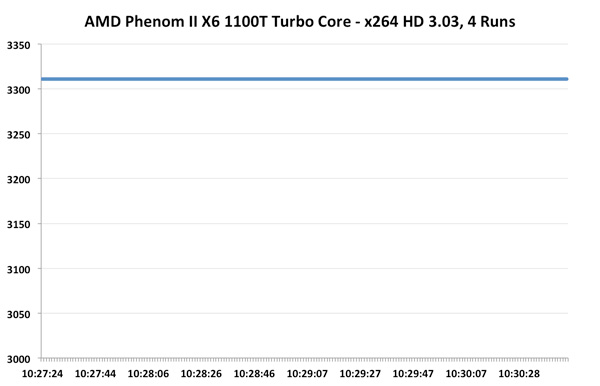
Unfortunately we see nothing of the sort. Turbo Core is pretty much non-functional on the Phenom II X6, at least running this workload. Average clock speed is a meager 3.31GHz, just barely above stock and likely only due to ASUS being aggressive with its clocking.
Now let's look at the FX-8150 with Turbo Core. The base clock here is 3.6GHz, max turbo is 4.2GHz and the intermediate turbo is 3.9GHz:
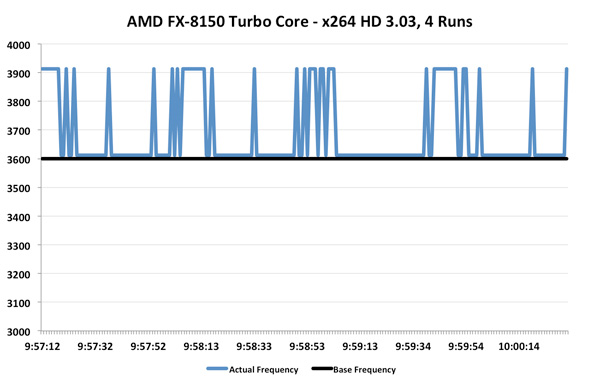
Ah that's more like it. While the average is only 3.69GHz (+2.5% over stock), we're actually seeing some movement here. This workload in particular is hard on any processor as you'll see from Intel's 2500K below:
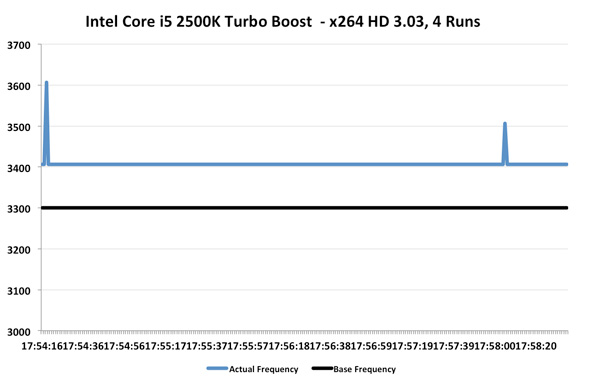
The 2500K runs at 3.3GHz by default, but thanks to turbo it averages 3.41GHz for the duration of this test. We even see a couple of jumps to 3.5 and 3.6GHz. Intel's turbo is a bit more consistent than AMD's, but average clock increase is quite similar at 3%.
Now let's look at the best case scenario for turbo: a heavy single threaded application. A single demanding application, even for a brief period of time, is really where these turbo modes can truly shine. Turbo helps launch applications quicker, make windows appear faster and make an easy time of churning through bursty workloads.
We turn to our usual favorite Cinebench 11.5, as it has an excellent single-threaded benchmark built in. Once again we start with the Phenom II X6 1100T:
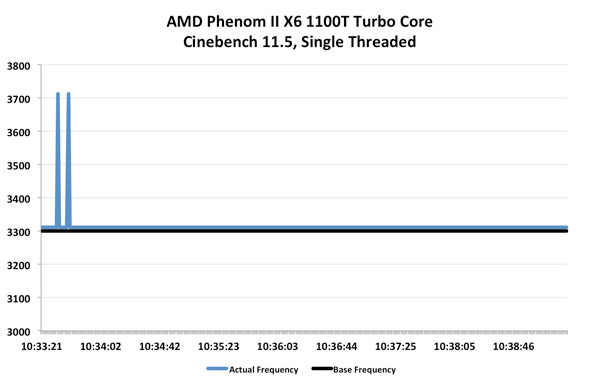
Turbo Core actually works on the Phenom II X6, albeit for a very short duration. We see a couple of blips up to 3.7GHz but the rest of the time the chip remains at 3.3GHz. Average clock speed is once again, 3.31GHz.
Bulldozer does far better:

Here we see blips up to 4.2GHz and pretty consistent performance at 3.9GHz, exactly what you'd expect. Average clock speed is 3.93GHz, a full 9% above the 3.6GHz base clock of the FX-8150.

Intel's turbo fluctuates much more frequently here, moving between 3.4GHz and 3.6GHz as it runs into TDP limits. The average clock speed remains at 3.5GHz, or a 6% increase over the base. For the first time ever, AMD actually does a better job at scaling frequency via turbo than Intel. While I would like to see more granular turbo options, it's clear that Turbo Core is a real feature in Bulldozer and not the half-hearted attempt we got with Phenom II X6. I measured the performance gains due to Turbo Core across a number of our benchmarks:

Average performance increased by just under 5% across our tests. It's nothing earth shattering, but it's a start. Don't forget how unassuming the first implementations of Turbo Boost were on Intel architectures. I do hope with future generations we may see even more significant gains from Turbo Core on Bulldozer derivatives.
Independent Clock Frequencies
When AMD introduced the original Phenom processor it promised more energy efficient execution by being able to clock each core independently. You could have a heavy workload running on Core 0 at 2.6GHz, while Core 3 ran a lighter thread at 1.6GHz. In practice, we felt Phenom's asynchronous clocking was a burden as the CPU/OS scheduler combination would sometimes take too long to ramp up a core to a higher frequency when needed. The result, at least back then, was that you'd get significantly lower performance in these workloads that shuffled threads from one core to the next. The problem was so bad that AMD abandoned asynchronous clocking altogether in Phenom II.
The feature is back in Bulldozer, and this time AMD believes it will be problem free. The first major change is with Windows 7, core parking should keep some threads from haphazardly dancing around all available cores. The second change is that Bulldozer can ramp frequencies up and down much quicker than the original Phenom ever could. Chalk that up to a side benefit of Turbo Core being a major part of the architecture this time around.
Asynchronous clocking in Bulldozer hasn't proven to be a burden in any of our tests thus far, however I'm reluctant to embrace it as an advantage just yet. At least not until we've had some more experience with the feature under our belts.


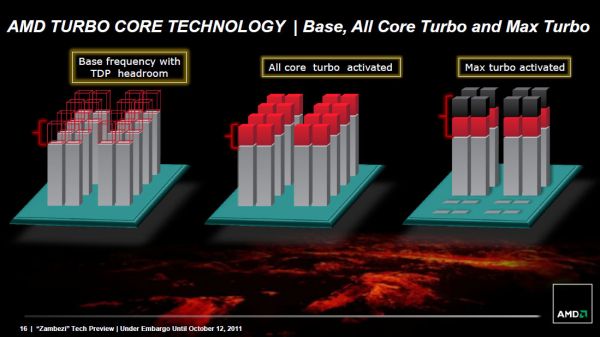








430 Comments
View All Comments
AmdInside - Wednesday, October 12, 2011 - link
Their roadmap is aggressive but when is the last time AMD has come close to meeting their schedule? Not going to happen. But do hope that they do for consumers sake.Eagle70ss - Wednesday, October 12, 2011 - link
AMD really bent over and grabbed their ankles....I'm just wondering why it took so long to release douche-dozer...I was really hoping they would have a good part this time...Will Intel stand alone as the sole quality CPU maker?? Only time will tell, but it looks to be so....silverblue - Wednesday, October 12, 2011 - link
I must say, I did expect this. That price drop wasn't exactly a giveaway, was it? Single threaded performance is generally poor and there really is something wrong with the caching. I simply refuse to believe a lack of BIOS optimisations is at fault for any of this... and blaming Windows 7 for not truly understanding Bulldozer's idiosyncracies? Come off it; Windows 8 won't even be around when Piledriver appears, and we'll have to wait to see the second generation of this particular microarchitecture performing more like it "should". Bringing back the FX moniker certainly attracted attention, however if by doing so they wanted to remind us of the fact that the FX-51 was a server CPU, they've succeeded, if only on that basis, as the FX was king of all and not just in select benchmarks as the P4 tended to be.I can't wait for Johan's server review; I just want to see if this thing really does well in its natural habitat. It's got to have a success somewhere. Thankfully, I can see far more optimism in this area. Incidentally, I was expecting Bulldozer to be able to work on eight 128-bit FP instructions per clock as opposed to 6 with Thuban, so obviously I got my wires crossed on that one.
You can't argue that Bulldozer hasn't a lot of promise, but at the same time, you can't argue that AMD haven't been trying to perform damage limitation on an already faulty product.
arjuna1 - Wednesday, October 12, 2011 - link
Nobody, and I mean, nobody at all, expected Bulldozer to reach SB like performance, obvious nobody either saw sub Phenom II performance in certain applications, but almost everything promised has been delivered, at lower prices than Intel, the way AMD has always done it, and quoting the article:"In many ways, where Bulldozer is a clear win is where AMD has always done well in: heavily threaded applications. If you're predominantly running well threaded workloads, Bulldozer will typically give you performance somewhere around or above Intel's 2500K."
PS
wolfman3k5, stop your Intel shilling, it almost look like if Intel was paying you by the hour.
wolfman3k5 - Wednesday, October 12, 2011 - link
I get $22.50 per hour from Intel plus tips. I also get a $50.00 bonus if I surpass 1000 comments / posts per day. Between 3:00AM and 7:00AM I get $25.85 per hour. I make good money writing nice things about Intel. What do you do?g101 - Wednesday, October 12, 2011 - link
What's surprising is that you apparently think that's "good money".Guess what, you little dumbshit kid, profit savvy professionals will sill be running AMD. I couldn't care less about your shitty lightly threaded games and optimized synthetic benchmarks.
Stupid children using their computers for play.
silverblue - Friday, October 14, 2011 - link
You need to bear in mind that a) AMD reintroduced the FX brand just for Zambezi, and b) JF-AMD actually started a thread entitled The Bulldozer Blog Is Live! on www.overclock.net. Regardless of whether John Freuhe is a server-focused guy or not, the point being is that he and AMD both targetted the client side in terms of i) overclockers and ii) gamers. I might be wrong, but that's how I see it. Yes, he didn't come out and say it directly that Zambezi would be a great gaming solution, but he DID say that IPC would be an improvement over their past products. Now that the reviews are out, he's nowhere to be seen, barring the odd login to do who-knows-what. Does overclock.net have any leaning towards the server market in any way?If Zambezi's poor performance is partly down to using faulty ASUS boards/anything less than 1866MHz RAM/an L1 cache bug/some weird hardware combinations/WHATEVER, I'm sure we'll find out in time, but regardless, it's going to be harming non-gaming workloads as well, so it's important to people like you as well.
silverblue - Friday, October 14, 2011 - link
Just thought I'd say that I've been a bit harsh to JF there. Out of all the AMD people who could've come along to have a chat, he was definitely the bravest. It was on his free time, and he's probably getting copious amounts of hate messages just for being an AMD rep.Proxicon - Wednesday, October 12, 2011 - link
I stayed up all night to read this review....I guess the prices on 2600k won't be going down anytime soon. I had already built my complete system in my head. Then the reviews came..
I kind of figured that if AMD was firing people and resignations were being handed in before a major launch, it wasn't going to be good. Also, no early release of benchmarks. That in itself was suspect. If they really had such a great processor than why all the secrecy. I was hoping it was an Apple play. boy, was I wrong.
You guys buy the "faildozer" and help keep the prices of the 2600K low. I'll be looking for a 2600K....
3DVagabond - Wednesday, October 12, 2011 - link
I'm not an expert, but Bulldozer seems to be a server chip pressed into desktop service. Designed for highly threaded workloads many consumer tasks just aren't it's forte (and also designed to have even more cores than 8). While it isn't competitive in single thread performance, if you use highly threaded workloads enough and aren't afraid to O/C to boost the single core performance, Bulldozer can be the better chip. That is if the price is right. The 8120 might be an awesome value in this scenario. We'll have to wait for reviews to be sure.One question, please. When you O/C'd the 8150, did you only use stock cooling? From the review it sounded like you did, but instead of saying so clearly, you said it wouldn't do 5GHz on "air" (I believe that was the statement? Feel free to flame me if I'm wrong. :D). So, to be clear, would it not do 5GHz on air with a top notch cooler, or did you only try the stock cooler?
Thanks.